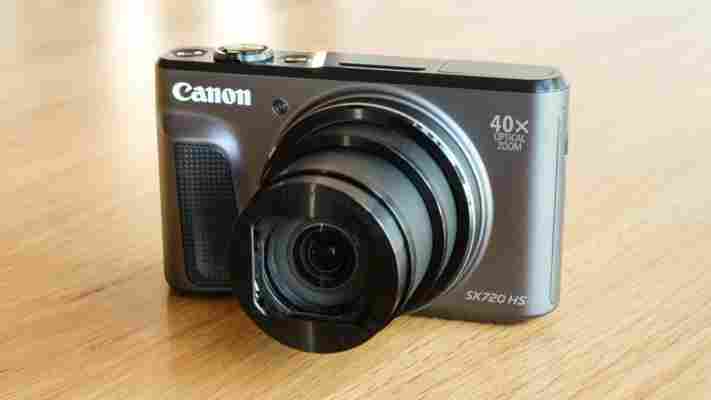The Canon SX720 HS is a compact camera with a 40x zoom lens, smashing the record of 30x jointly held by Canon, Nikon, Panasonic and Sony. This is great news for people who like to shoot distant subjects but who don’t want to lug a bulky camera around. However, this extra zoom extension is only useful if the camera can produce sharp photos at the full zoom extension. It’s a challenge not just for the lens optics but also for stabilisation and noise handling.
These issues are all the more pressing in a compact-shaped camera. Cramming a 40x zoom into a camera that’s just 38mm thick can’t be easy, or else everyone would be doing it. It remains to be seen whether Canon’s move to 40x is based on technical progress or demands from the marketing department.
Stabilisation is harder, too — or to be more precise, it’s harder to hold a small, slim camera steady. An SLR-shaped camera’s additional size and weight give it some inertia. With a slim compact camera, the slightest movement can make the subject disappear out of shot.

Noise is perhaps the biggest challenge for a compact camera with a big zoom. Zooming in exaggerates camera shake so faster shutter speeds are necessary. Zooming in also shrinks the maximum aperture — in this case from f/3.3 for wide-angle to f/6.9 for telephoto, or a quarter the amount of light. A faster shutter speed and smaller aperture both mean less light hitting the sensor, so the ISO speed must be raised to compensate, and this raises noise levels. Noise is always an issue for cameras with tiny 1/2.3in sensors, and it’s particularly challenging here.
So the SX720 HS has its work cut out if it wants to impress. It makes a good first impression with a smart appearance in a choice of gunmetal grey or dusky red finishes. The layout of buttons is geared more towards point-and-shoot users but it’s good to see an exposure mode dial and a rear wheel for quick adjustment of settings.
There’s not much of a handgrip but the rubber texture and the position of the mode dial means it feels secure in the hand. I found that the optical stabilisation was just as useful when composing shots as when taking them. Tracking moving subjects at the full 960mm (equivalent) zoom position is virtually impossible, so thankfully there’s a button that quickly zooms out to help find the subject. Releasing the button zooms back in again. The same button can be used to make the camera zoom automatically to frame a person’s face, upper body or whole body. I don’t believe there are many people who wouldn’t prefer to use the zoom lever and makes these decisions for themselves, but somebody somewhere might appreciate it.

Big zooms are useful for sports and wildlife photography, but these also require fast performance. The SX720 HS fared reasonably well in this respect, taking around half a second to focus and 0.9 seconds on average between shots. Flash photography was less impressive, taking 8.5 seconds to recharge at full flash power. Continuous mode ran at 6fps until the card was full. Enabling continuous autofocus delivered 2.8fps shooting, but I saw little evidence of it successfully tracking moving subjects.
A bigger frustration are the limited autofocus options. There’s a choice of multi with face detection, centre or tracking, but no option to position the autofocus point anywhere in the frame. Most compact cameras don’t really need this but focus becomes more critical for telephoto shots where there’s a narrow depth of field. I selected the Centre AF mode and regularly had to focus on the subject, reframe it off-centre and then take the shot.
Video quality
Video mode can be a pocket ultra-zoom camera’s secret weapon, as the smaller 2-megapixel resolution of 1080p video is more forgiving of lens sharpness and sensor noise issues. I certainly appreciated the 40x zoom when shooting videos of wildlife at Minsmere RSPB reserve. Video stabilisation worked well, although the results were invariably better when I had something solid to prop my arms against.
Video quality was good rather than great, with a slight coarseness to details. Shooting in low light resulted in a fair amount of noise but noise reduction kept it under control. It’s disappointing that there’s no option to control the video exposure manually.







Leave a Reply